To use your vertical space fully, start by evaluating your room’s layout and identifying forgotten or high areas like above doorways or between cabinets. Install sturdy shelves, overhead cabinets, or ceiling racks supported by proper hardware. Use pulley systems for heavy items and add vertical organizers like hooks or wall shelves for everyday essentials. Choosing multifunctional furniture helps maximize space. If you explore more, you’ll discover even smarter ways to transform your space into a clutter-free haven.
Key Takeaways
- Measure ceiling height and identify high or unused areas for custom overhead storage solutions.
- Install sturdy wall-mounted shelves and ceiling racks at varying heights to maximize vertical organization.
- Use pulley systems and ceiling-mounted cabinets for heavy or seasonal items, freeing up floor space.
- Incorporate vertical organizers like wall shelves, hooks, and over-the-door baskets for flexible storage.
- Choose multi-functional furniture with built-in storage and floor-to-ceiling units to optimize vertical space utilization.
Assessing Your Space and Planning Your Layout

Before organizing your space, you need to assess what you have. Start by measuring your vertical space, including wall height, ceiling height, and any beams, to identify potential storage areas. This space assessment helps you understand the limits and possibilities for layout planning. Look for high or seldom-used spots, like above doorways or between cabinets, that can be optimized for extra storage. Categorize your items by how often you use them, so you know which should be easily accessible and which can go higher. Use design visualization tools or sketches to plan a layout that balances functionality and aesthetics. This careful evaluation ensures your vertical space is maximized, and your storage solutions fit seamlessly into your room’s structure. Incorporating storage optimization techniques can further enhance the efficiency of your vertical space utilization.
Installing Wall-Mounted Shelves and Cabinets
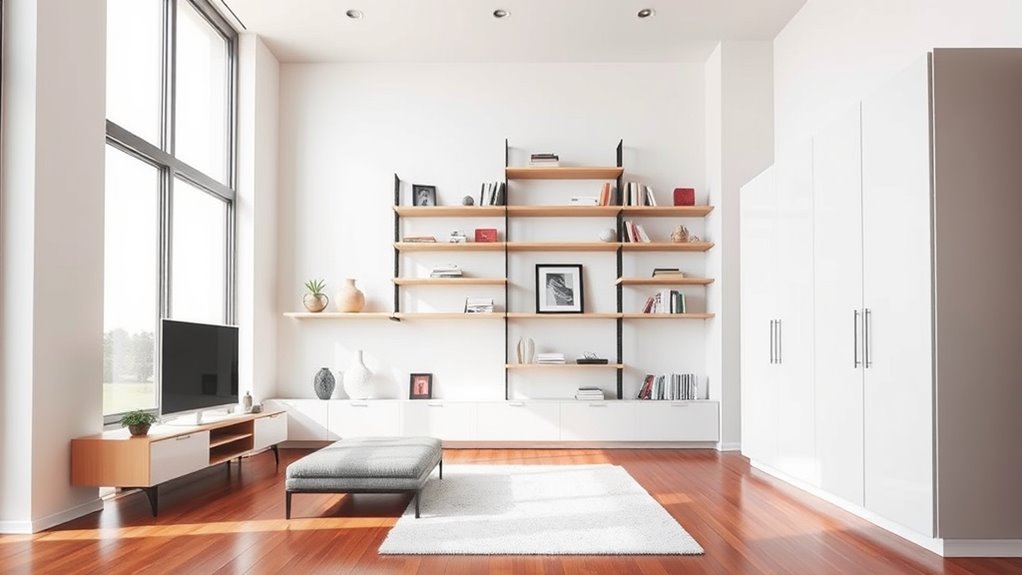
When installing wall-mounted shelves and cabinets, using proper mounting techniques is key to ensuring stability and safety. You need to consider weight capacity to prevent sagging or damage, especially for heavier items. You should also assess the relationship dynamics within your space to determine the most functional placement. Placing shelves at ideal heights maximizes space and keeps your organization both functional and accessible. Selecting sturdy mounting hardware designed for your wall type can further enhance the durability and safety of your installations. Additionally, understanding contrast ratio and choosing appropriate materials can improve the visual appeal and longevity of your setup. Consulting with a professional or referring to interior design best practices can provide valuable insights for creating a cohesive and effective storage solution. Being aware of hackathon best practices for collaboration and problem-solving can also inspire innovative ways to optimize your storage solutions and organization strategies.
Proper Mounting Techniques
Proper mounting techniques are essential to guarantee your shelves and cabinets are secure and safe. First, locate wall studs with a stud finder to ensure proper support. Use the right hardware, such as anchors and screws rated for your wall type, to firmly attach your fixtures. For heavier units, support weight distribution by installing multiple mounting points and reinforcing them with additional hardware if necessary. Careful measuring and leveling of brackets prevent crooked shelves and cabinets. Follow manufacturer instructions regarding hardware and weight limits, and consider reinforcing mounting points for heavier loads. Proper mounting not only prevents sagging or failure but also ensures your wall-mounted units stay secure over time, maximizing your vertical space safely and efficiently. Additionally, selecting appropriate hardware and installation techniques helps protect your wall surfaces and prolongs the lifespan of your mounted items. When mounting, it’s also helpful to use proper tools such as a level and drill to ensure precision and stability. Remember that understanding security measures in payment processing can influence how you choose your hardware to prevent tampering or accidental dislodging. Incorporating appropriate load distribution methods can further enhance the safety and durability of your wall-mounted storage.
Weight Capacity Considerations
Ensuring your wall-mounted shelves and cabinets can safely support the intended load starts with checking the manufacturer’s weight capacity ratings. This guarantees you stay within safe weight limits and maintains structural integrity. Use appropriate wall anchors and mounting hardware designed for your wall type—drywall, concrete, or otherwise—to support the maximum load. Distribute weight evenly across the shelf or cabinet to prevent stress points that could cause shelf sagging or damage. Avoid exceeding recommended weight limits, as this can lead to shelf warping, detachment, or wall damage over time. Regularly inspect your mounted storage for signs of wear, loose brackets, or sagging to ensure safety and maintain the load’s balanced distribution. Proper attention to weight capacity and load distribution is crucial for maximizing safety and durability when using vertical storage solutions. Additionally, understanding the importance of industry standards and proper installation techniques can help you create a more functional and safe workspace at home.
Optimal Shelf Placement
Installing wall-mounted shelves at varying heights allows you to maximize vertical space while keeping frequently used items within easy reach. Proper placement guarantees efficient storage and a clean look. Use heavy-duty brackets and anchors suited to your wall type to securely support heavier items. Place items you access daily on lower shelves, reserving higher ones for decorative or seldom-used objects. Align the bottom edge with architectural features like window sills or crown molding for a cohesive appearance. Maintain at least 12 inches of spacing between shelves to accommodate different item heights comfortably. Additionally, considering home decor themes can help create a harmonious and stylish environment. Incorporating self watering plant pots on your shelves can also add a touch of greenery while reducing maintenance efforts. By understanding creative practice principles, you can experiment with different arrangements to enhance both functionality and aesthetics. Exploring space-saving techniques can further optimize your storage solutions and keep your space clutter-free.
Utilizing Overhead and Ceiling Storage Solutions
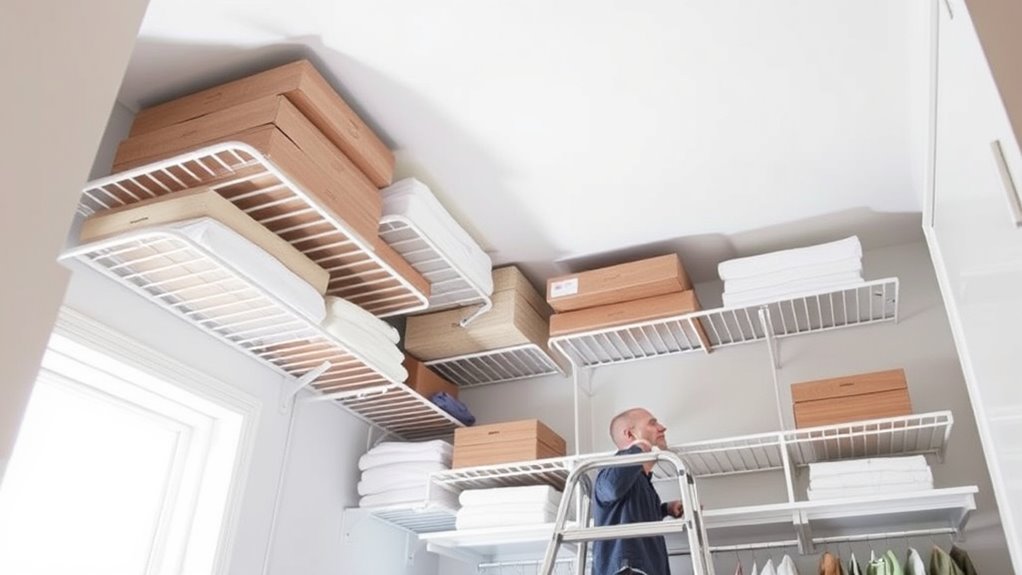
Ceiling racks, overhead cabinets, and pulley systems release valuable vertical space in your home. They make it easy to store heavy or seasonal items out of the way while keeping them accessible when needed. Proper installation and weight considerations guarantee these solutions are safe and effective for your space. Additionally, ensuring you do not overload storage areas helps prevent accidents and maintains the integrity of your storage solutions, especially when dealing with weight limits. Incorporating office furniture ergonomics or other lightweight items can help prevent overloading and ensure safety. As automation continues to advance in various industries, understanding data privacy challenges becomes crucial to maintain security and compliance in your storage and organizational systems. Furthermore, integrating security zone info insights can help you evaluate the safety and security of your storage solutions.
Installing Ceiling Racks
To make the most of your garage or storage space, ceiling racks offer an effective solution for overhead organization. Proper installation is key to safety and stability, so you must secure your ceiling racks into ceiling joists or beams. Before installing, check the weight capacity to guarantee it can handle your items without risking collapse. Here are four essential steps:
- Locate ceiling joists using a stud finder for secure anchoring.
- Mark the mounting points precisely to ensure balanced weight distribution.
- Use heavy-duty hardware designed for overhead storage.
- Confirm the racks are firmly attached and test their stability before loading.
Using Overhead Cabinets
Maximizing your vertical space is an effective way to keep your home organized and clutter-free, especially in areas like kitchens and garages. Overhead cabinets utilize ceiling height, offering extra storage solutions by extending from the ceiling to the floor. These cabinets help maximize storage for seldom-used items, freeing up valuable counter and floor space. Ceiling-mounted racks and custom cabinetry can be tailored to fit your space perfectly, supporting heavy loads like tools or seasonal decor. Proper placement and using step stools or ladders ensure safe, convenient access. By integrating overhead cabinets into your storage plan, you optimize vertical space, improve organization, and make the most of your ceiling height. This approach transforms unused space into a practical storage asset.
Employing Pulley Systems
Employing pulley systems adds a practical dimension to overhead and ceiling storage solutions by making heavy or bulky items easier to access. With pulley systems, you can efficiently use ceiling storage for seasonal gear, tools, or sports equipment, saving floor space. Consider these key points:
- Choose durable pulleys capable of supporting 100-500+ pounds for safety and reliability.
- Use motorized pulleys for effortless overhead lifting, controlled via remote or smart home devices.
- Securely mount pulley systems to ceiling joists and ensure proper weight distribution to prevent accidents.
- Maintain ceiling mounts and pulley alignment for smooth operation and longevity.
Proper installation and maintenance ensure safe, functional overhead lifting, maximizing your vertical space effectively and securely.
Incorporating Vertical Organizers and Hanging Storage
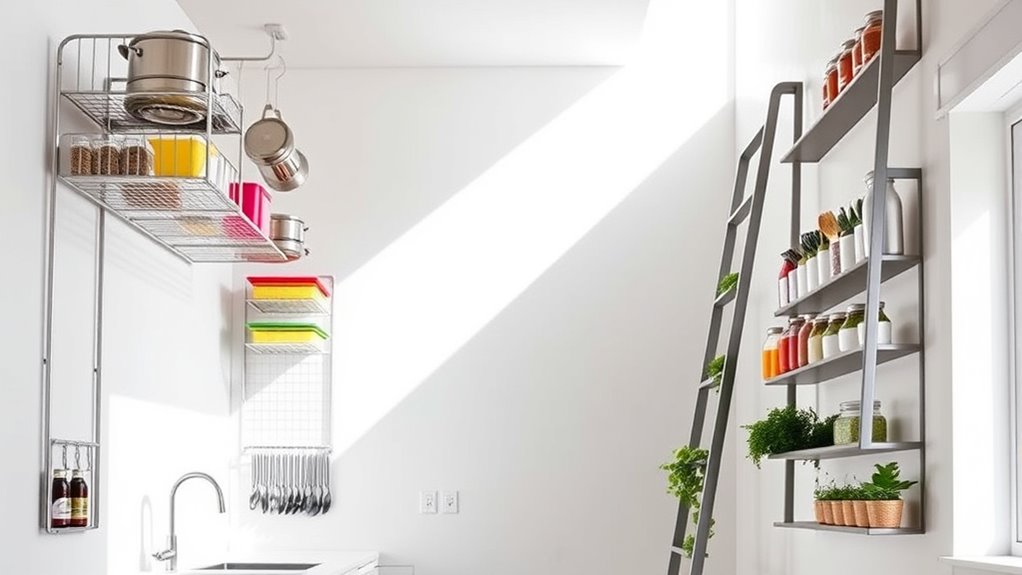
Have you considered how vertical organizers and hanging storage can transform your space? Installing floating shelves and wall-mounted units maximizes wall space, giving you spots for books, decor, or essentials without cluttering the floor. Ceiling racks and over-the-door baskets utilize overhead and door areas, keeping kitchens, bathrooms, and entryways tidy and accessible. Wall-mounted desks and TV mounts free up valuable floor space while creating functional zones. Hooks and hooks-based systems on walls or doors provide flexible storage for coats, bags, keys, and accessories, keeping everything organized. Vertical planters and wall-mounted gardens turn plain walls into lush, green displays, enhancing air quality and visual appeal. By integrating these solutions, you optimize your vertical space and keep your environment neat and functional.
Choosing Multi-Functional and Tall Furniture Pieces
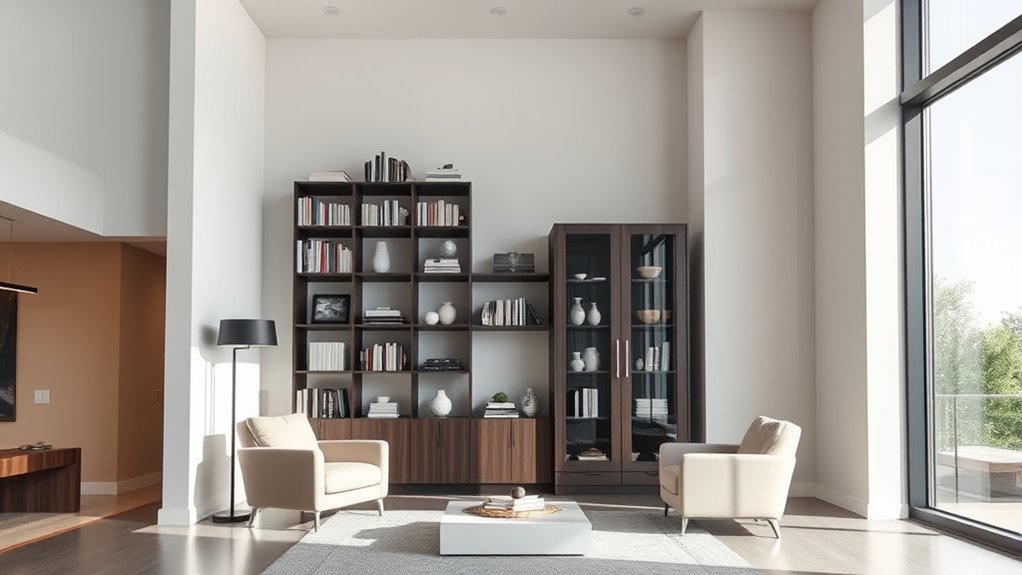
Building on the idea of using vertical space through organizers and wall-mounted storage, choosing multi-functional and tall furniture pieces helps maximize your space even further. These pieces combine multiple functions, like storage and seating, with features like adjustable shelves and built-in compartments. Tall furniture, such as floor-to-ceiling bookshelves and vertical cabinets, leverages high wall areas without taking up valuable floor space. Modular furniture allows you to customize height and configuration, fitting your room’s dimensions perfectly. Wall-mounted units and concealed storage options keep clutter hidden, maintaining a clean look. Consider furniture with built-in features, like headboards with storage or wall-mounted beds with underneath compartments, to optimize vertical space smartly and efficiently.
Decorating to Enhance Perception of Height and Space
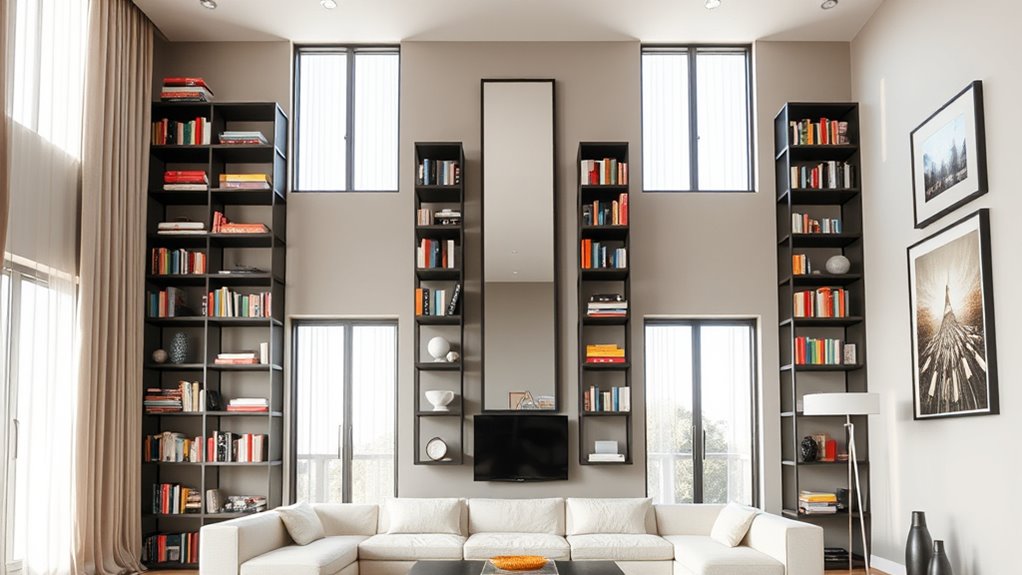
Ever wonder how to make your room feel more spacious without adding square footage? Decorating strategically can enhance your vertical space and improve room height perception. Use tall mirrors to reflect natural light, creating the illusion of higher ceilings and expanding the space visually. Incorporate vertical design elements like tall bookshelves, wall-mounted artwork, or curtains hung closer to the ceiling with high curtain rods to draw the eye upward. Highlight ceilings with lighting solutions that emphasize verticality, such as pendant lights or wall sconces. Painting walls and ceilings in light, neutral colors minimizes visual boundaries, fostering a sense of openness and verticality. Thoughtful decorating choices can transform your room into a more spacious, inviting environment by enhancing its perceived height and space.
Maintaining and Adjusting Your Vertical Storage System

To keep your vertical storage system functioning smoothly, it’s important to regularly evaluate how well it meets your needs. This helps identify overcrowded or underused areas, so you can make necessary adjustments. Use adjustable shelving and modular units to reconfigure storage height and organization as your needs change. Keep frequently accessed items within arm’s reach on lower shelves, and store seldom-used items higher up to improve accessibility. Periodically purge and reorganize to prevent clutter buildup and maintain efficiency. For safety, secure heavy or high-mounted units properly, and use step stools or ladders for top shelves. To optimize your system, consider these steps:
- Reconfigure storage with modular units
- Regularly purge and reorganize
- Secure units for safety
- Adjust shelving based on access needs
Frequently Asked Questions
How Do You Maximize Vertical Space?
To maximize vertical space, you should install tall cabinets or shelving that reach the ceiling for extra storage. Use wall-mounted or floating shelves for easy access to frequently used items without taking up floor space. Hang hooks, over-the-door organizers, or ceiling racks to free up horizontal surfaces. Employ stackable bins and vertical dividers for small items, and consider custom or modular systems to make the most of awkward or underused areas.
How Do You Maximize Vertical Closet Space?
Think of your closet as a towering skyscraper waiting to be fully occupied. You can maximize vertical space by installing high shelves that reach the ceiling, giving your storage a sky-high boost. Use multi-tiered hangers and stacking bins like building blocks, and add a mini ladder for easy access to the top floors. With clever organization, your closet becomes a well-structured cityscape of storage, efficient and expansive.
How to Use Vertical Cabinet Space?
To use vertical cabinet space effectively, install tall cabinets that reach the ceiling, making the most of often overlooked upper areas. Use adjustable shelves to customize storage heights for different items, and incorporate pull-out trays or baskets for easy access to contents at the back. Stack containers to maximize space inside, and keep a step stool nearby to safely reach the highest shelves, ensuring you utilize every inch efficiently.
How to Maximize Vertical Space in a Pantry?
To maximize vertical space in your pantry, install adjustable shelves close together to boost storage capacity. Use clear, labeled bins for easy access, and stackable containers to save space on dry goods. Hang hooks or small racks inside doors for utensils or spices, and add vertical dividers or tiered risers on shelves to create multiple levels. These tips help you organize efficiently and utilize every inch of your pantry.
Conclusion
By maximizing vertical space, you turn your room into a functional, open area. Imagine adding wall shelves to a small kitchen, freeing up countertop space and keeping essentials within reach. With careful planning and smart storage choices, you’ll create a clutter-free environment that feels larger and more inviting. Start small—perhaps a tall cabinet—and watch your space transform. The key is to think vertically and stay adaptable, making your space work smarter, not harder.









